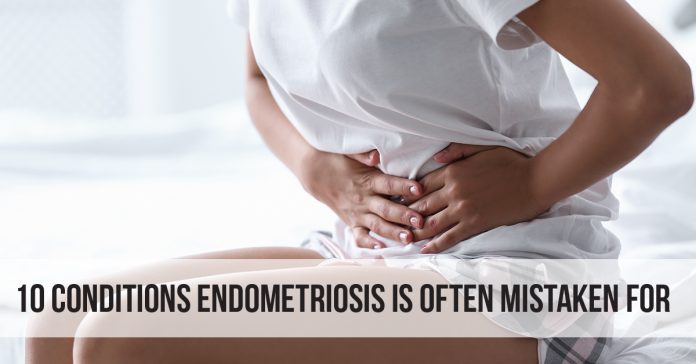Endometriosis is more common than once thought. It has been misdiagnosed and understudied from years. It has recently been determined that girls as young as 8 can be diagnosed with it. It can cause pain, bleeding, and even infertility. Endometriosis can spread. It can even get worse during pregnancy. As hard as it is to diagnose, there are treatment options that can relieve symptoms and keep it from spreading. The best thing you can do when you learn you have endometriosis is to learn all you can. Knowledge is the one thing that can give you hope and answers.
What is Endometriosis
Endometriosis causes extra tissue to grow in around the uterus. It can cause the tissue to grow around the fallopian tubes, ovaries, and even up to around the abdomen and lungs. It can occur in any female at any time. This condition is painful. The symptoms can be treated. Often, surgery is needed to control the growth and ease the pain.

What are the Symptoms of Endometriosis?
The symptoms are often missed or diagnosed incorrectly because there is not a whole lot known about endometriosis. You should seek a doctor that specializes in endometriosis, not all ob-gyn is knowledgeable with endometriosis or have the experience to offer the best treatment options.
Here are some of the symptoms:
Pain – as you can imagine, it can hurt to have the tissue to grow where it should not be. Whether it is a slight thickening of the uterus itself or tissue-like lining growing outside the uterus, it does not feel good. The pain can feel like cramps, lower back pain, or an achy not so good feeling pain.
Heavy bleeding – if your menstrual cycle means that you are going to be bleeding for weeks or soaking more pads than should be humanly possible, you may have endometriosis. In fact, along with pain, this is one of the very first symptoms noticed by most women.
Digestive Issues – you could experience diarrhea, a full feeling, constipation, chronic digestive issues, or even the inability to digest certain foods. This symptom is not often thought to be related to endometriosis. It is usually treated separately as a condition on its own.
Fertility Complications – The extra tissue can make it hard to conceive because it is in the way. It is interesting to know that pregnancy was once thought to be a cure to endometriosis when it caused problems simply trying to get pregnant. Usually once pregnant, it slows it down, but it doesn’t always stop it from progressing.
So now we will look at what it often gets mistaken for. As more research is done, we learn that sometimes we are simply treating the symptoms and missing the disease altogether.

The Ten Conditions Endometriosis is Often Mistaken For:
- PCOS
PCOS is the abbreviation for Polycystic Ovary Syndrome. Women with PCOS often have irregular cycles. They experience heavy cramps due to irregular or missing ovulation. Pelvic pain is common. Lower backache around the time of a cycle is common. If you have PCOS you may not know when to expect your cycle, so you may dismiss the pain. Endometriosis causes pain throughout the month and not just around the time of your cycle. Keep track of when your pain comes, when your cycle should be expected, and how long the pain lasts. Your doctor will also want to try birth control as a way to balance out your cycle before they look at endometriosis as a likely condition.
- Bladder Infection
It might sound odd that a bladder infection can actually be endometriosis, but if you take a closer look, it makes sense. A bladder infection can cause pelvic pain bad enough to make you not want to move. Endometriosis can make it feel like you need to pee and can’t if there is tissue pressing onto your bladder. Also, if you get frequent bladder infections, you may miss all the other signs that point to endometriosis thinking that they are just symptoms of your bladder infection. A urine test can rule out bladder infections, but you will need deeper testing to prove that endometriosis is causing your issues rather than a bladder infection.
- PID
PID stands for pelvic inflammatory disease. It is a condition that should not be messed with. It can cause pain for which you feel there is no relief. You will have heavy bleeding. It also affects more than just your uterus. You may have pain in your ovaries and fallopian tubes as well. The two conditions can be very hard to tell apart. Your doctor may need you to track your symptoms all month long and not just around the time of your cycle. Tracking your symptoms could possibly rule out endometriosis. It could also show your doctor that you need a laparoscopy and a possible biopsy of the tissues within your uterus.
- IBS
IBS stands for irritable bowel syndrome. It is a condition that causes cramps and a full feeling. These cramps can range from moderate to severe. They can last for a few minutes to a couple of days. The best way to distinguish between the two is to keep a food diary. If your diet and medications cannot fix your symptoms, then you may need to get a colonoscopy or another test so that the doctor can see the inside of you and make a better diagnosis.
- Sciatica
Sciatica is a dislocation of the nerves along the spinal cord. Endometriosis causes pain as the tissue spreads. This means as the pain moves more towards the back, your doctor may assume sciatica is the problem rather than endometriosis. You will need to keep track of all your symptoms to see the patterns and rule out sciatica. You will also want to make sure you find an ob-gyn that is experienced with endometriosis so that they know what to look for. Often, treatment for sciatica is pain relief which can cause more problems.
- Uterine Fibroids
Uterine Fibroids are also known as myomas. The symptoms are heavy bleeding, painful periods, back pain, and pelvic pain. These are very similar to Endometriosis. Not only can it make distinguishing between the two almost impossible, but it can also make diagnosing endometriosis very tricky. You may need to have surgery and biopsy to determine the cause. Keep track of your symptoms and what relieves the symptoms so that your doctor can find the best treatment plan for you.
- IC
IC Stands for Interstitial Cystitis. It is known as chronic bladder inflammation. It can be in addition to endometriosis which is why they get confused. Both do cause pelvic pain. However, it should be noted that IC does not usually affect your cycle or how heavy it is.
- Pelvic Floor Dysfunction
Pelvic Floor Dysfunction is the loosening of the pelvic floor. This can cause pain with sex, painful periods, the inability to control the pelvic floor, and some movements. While some symptoms do sound like endometriosis, there are some noticeable differences. For instance, if you have pelvic floor dysfunction you will not be able to stop and start urination and you may have several bowel movements in a short period of time. Pelvic floor dysfunction can affect both men and women whereas endometriosis only affects women.
- Primary dysmenorrhea
This condition is characterized by extremely painful cramps right around menstruation. Usually, this pain is accompanied by throwing up, nausea, headaches, body aches, and mood swings. Some have even said it is like having the worst period ever imagined every single month. The reason it is often mistaken for endometriosis is that they have the same symptoms. It would be very easy to confuse the two conditions. Most often, you need exploratory surgery to determine that it is endometriosis and not primary dysmenorrhea. Your doctor may want to take a sample of the tissue and do a biopsy before they make a definitive diagnosis.
- Adenomyosis
Adenomyosis and Endometriosis have many common symptoms including long periods that are heavy and painful. Both conditions can cause pain all month long. The difference is that endometriosis is the growth of tissue in and around the uterus while Adenomyosis is caused by glands and fluids that are found within the lining of the uterus. It can be very hard to determine which condition is affecting you. Most of the time you will need surgery and a biopsy to distinguish between the two. Treatment options could vary depending on the area and tissues that are most affected, but they are similar for both conditions.
We hope that you have found this article informative. Endometriosis can be managed once you get the proper diagnosis. It can be as simple as finding the right birth control options or as intensive as surgery to have the extra tissue removed. You should always go into every doctor appointment aware of your options so that you can have an honest discussion with your doctor.





